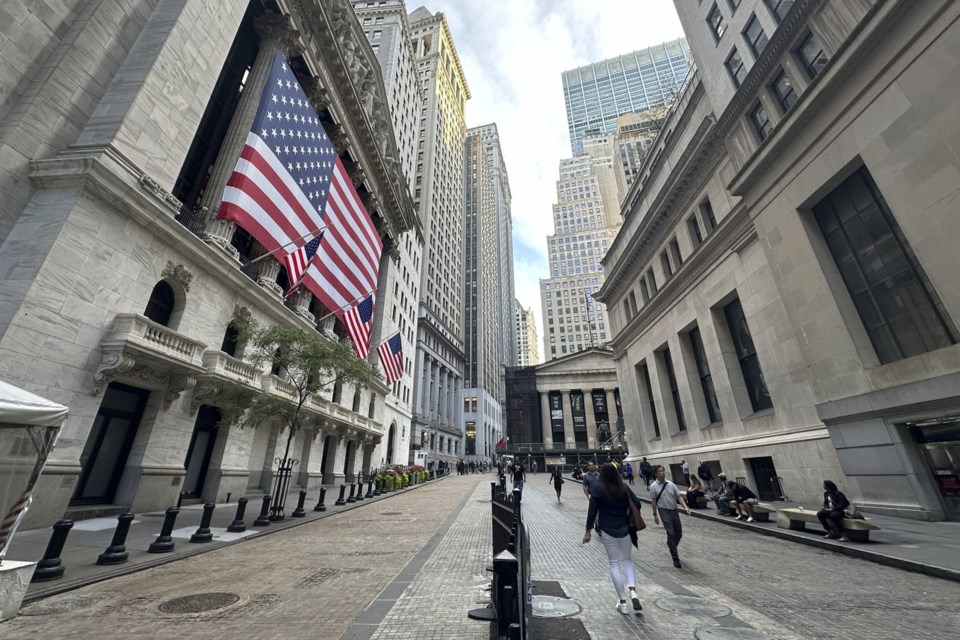NEW YORK (AP) — U.S. stocks rose closer to their all-time highs following a couple reports on the economy that came in close to expectations. The S&P 500 climbed 0.7% Thursday and pulled back within 1.3% of its record set in July. The Dow Jones Industrial Average gained 0.6%, and the Nasdaq composite jumped 1%. More gains for Nvidia and other Big Tech stocks drove the market higher, offsetting a slump for Moderna after the vaccine maker cut its plans for research-and-development investment. Treasury yields were relatively steady in the bond market following reports on layoffs and inflation that included few surprises.
THIS IS A BREAKING NEWS UPDATE. AP’s earlier story follows below.
NEW YORK (AP) — U.S. stocks are ticking closer to their all-time highs on Thursday following a couple reports on the economy that came in close to expectations.
The S&P 500 was 0.7% higher in afternoon trading and remains on track for a fourth winning week in the last five. It’s climbed back within 1.3% of its record set in July following a shaky summer.
The Dow Jones Industrial Average was up 147 points, or 0.4%, as of 3 p.m. Eastern time, and the Nasdaq composite was 1% higher.
Nvidia was the strongest force lifting the market and rose another 3% after jumping 8.1% the day before. The chip company's stock has stabilized recently after falling more than 20% during the summer on worries investors had taken it too high in their frenzy around artificial-intelligence technology.
It and other Big Tech stocks helped offset an 11.9% slump for Moderna after the vaccine maker said it expects to break even in 2028, pushing out its earlier prediction of 2026. The company, whose sales have cratered in the aftermath of the COVID-19 pandemic, is also reducing its 2025-2028 research and development investment by 20%.
Treasury yields were also holding relatively steady in the bond market following reports on layoffs and inflation that included few surprises. The data did little to change the overriding belief in the market that the U.S. economy is slowing, along with inflation, and that the Federal Reserve will deliver a cut to interest rates next week in hopes of protecting the job market and preventing a recession.
One report said the number of U.S. workers applying for unemployment benefits last week ticked up, though it remains low relative to history. Another said prices charged at the wholesale level were 1.7% higher in August than a year before. That’s a slowdown from July’s inflation rate, but an underlying measure that economists see as a better predictor of future trends also ticked up more than expected.
The inflation data was similar to Wednesday’s report on prices at the U.S. consumer level. It kept traders betting the Fed will deliver a traditional-sized cut of a quarter of a percentage point next week, instead of the larger half-point that some had earlier been expecting.
While lower interest rates help goose the economy and investment prices, they can also give inflation more fuel.
In the bond market, the yield on the 10-year Treasury edged up to 3.67% from 3.66% late Wednesday. It's steadying after sliding sharply since April on expectations for coming cuts to rates. That easing helped pull the average rate on a 30-year mortgage in the U.S. to its lowest level in 19 months, according to Freddie Mac.
Any cut to rates by the Fed would be the first in more than four years, as it’s been more focused on fighting inflation. Across the Atlantic, moves to protect the economy have already begun. The European Central Bank cut interest rates by a quarter of a percentage point on Thursday, the second time it’s done so to prop up economic growth.
Despite all the focus on how much the Fed will cut rates by in September, the more important factor is how much in total the Fed will ultimately cut, and how much the market has already priced in, say strategists at UBS. Many traders are forecasting total cuts of more than 2 percentage points over the next year, down from the federal funds rate's current range of 5.25% to 5.50%, according to data from CME Group.
“Any divergence from this path - whether from resurgent inflation or recessionary risks - will likely be received poorly by the market,” according to the strategists led by Jonathan Golub.
On Wall Street, Kroger climbed 5.8% after reporting stronger profit for the latest quarter than analysts expected. The grocer’s revenue fell short, but it raised the floor of its forecasted range for a key revenue measure for the full year.
Alaska Air Group rose 1.2% after raising its forecast for profit in the summer quarter. The airline said an important underlying measure of revenue will likely be up about 2% from a year earlier, better than the “flat to positive” forecast it earlier gave. Fuel costs are also likely to be lower than expected.
American Airlines gained 1.6% after its flight attendants voted to approve a labor contract and avert a possible strike.
In stock markets abroad, indexes were higher across much of Europe. In Asia, Japan’s Nikkei 225 index was a standout and jumped 3.4%. It clawed back some of its sharp losses following a seven-day losing streak.
___
AP Business Writers Yuri Kageyama and Matt Ott contributed.
Stan Choe, The Associated Press

